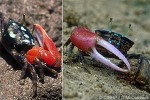Cook Islands Biodiversity Database
Species Page
Uca crassipes
Kō‘iti Raukuraa fiddler-crab
Multimedia & Additional Resources
| Type | Description | Download |
| Male - two views | 51KB | |
| Males in combat | 44KB | |
| Male on chimney built by female | 52KB |
General Information
Cook Islands Distribution
| Southern Group: Present Makatea: | ||||||||
RR |
MG |
AT |
MK |
MT |
AK |
PL |
TK |
MN |
P |
P? |
- |
^++++ |
|||||
| Northern Group: - | |||||
TN |
MH |
RK |
PK |
NS |
SW |
- |
- |
- |
|||
Scientific Taxonomy
Uca crassipes (Adams & White, 1848)
SYNONYMS: Gelasimus crassipes; Uca crassipes; Uca gaimardi; Uca latreillei; Uca splendidus; Uca chlorophthalmus crassipes [In the subspecies system U. c. chlorophthalmus is from e.Africa and throughout Indian Ocean; U. c. crassipes is from Malaysia and the Pacific to the Tuamotu.]
TAXONOMY: ANIMALIA; ARTHROPODA; CRUSTACEA; MALACOSTRACA; EUMALACOSTRACA; Eucarida; Decapoda; Reptantia; Brachyura; Brachygnatha; Brachyrhyncha; OCYPODIDAE
More Information
GENERAL NOTE: Uca crassipes, like other fiddlers, feed outside their burrows when the tide uncovers the substrate during daylight hours. Waving displays, combat, and courtship usually occur for 2 or 3 days of around Spring Tide. The large females usually build chimneys at this time and males approach the chimneys (sometimes waving). After courtship mating occurs on the ground, on the chimney or in the burrow. Male combat is ritualised and does not involve injury.
Vouchers & References
Vouchers:
Cooks: 042. Aitutaki: field-specimen, NBSAP School, 12/2000, ID GM.
References:
Special Reference: Forest & Guinot 1961 [Fr.]
Data Update History (information):
zTX, zB02, zM02, zupM06a, zD02, zupD06a
Web Resources
Citation Information
McCormack, Gerald (2007) Cook Islands Biodiversity Database, Version 2007.2. Cook Islands Natural Heritage Trust, Rarotonga. Online at http://cookislands.bishopmuseum.org. ![]()
Please refer to our use policy.

